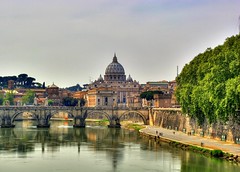In Paris we found 4 monuments that symbolized various aspects of the the historic city. Surely we can do the same with Roma, the Eternal City.
First, we will create a representation of St Peter's basilica, one of the world's spectacular churches - center of the Vatican City, home of the Pope. In its shadow we will tuck the Sistine Chapel, famous for its murals by Michelangelo.
Secondly, we must have the Roman Colosseum, one of the centers of gladiatorial energy in the late Roman Empire.
Thirdly, we need a representation of the Roman Forum, center of political discussions and of Roman governmental news.
Fourthly, we will memorialize the earliest extant domed building, the Pantheon. It represents an array of Roman gods and is symbolic of the success of Rome in engineering.
Wikipedia offers this list of the most important sites in Roma: the Colosseum (70–80 AD), the largest amphitheatre ever built in the Roman Empire. Originally capable of seating 60,000 spectators, it was used for gladiatorial combat. The list of important monuments of ancient Rome includes the Roman Forum, the Domus Aurea, the Pantheon, Trajan's Column, Trajan's Market, the Catacombs, the Circus Maximus, the Baths of Caracalla, Castel Sant'Angelo, the Mausoleum of Augustus, the Ara Pacis, the Arch of Constantine, the Pyramid of Cestius, and the Bocca della Verità.
Additionally, we have architectural symbols of Italy's historic grandeur in these sites:
* the Galleria in Milano.
* the town houses and palazzo built upon canals in Venezia.
* the Bell Tower of Pisa, on the Arno River.
* the Ponte Vecchio and Duomo Cathedral of Firenze / Florence - also on the River Arno.
* the Roman cities of Pompeii and Herculaneum, preserved by the eruption of Mt Vesuvius.
Sunday, December 14, 2008
Subscribe to:
Post Comments (Atom)


No comments:
Post a Comment